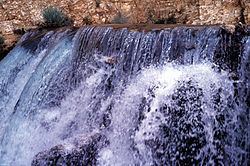Elevation 1,375 m | ||
 | ||
Yammoune is a lake, nature reserve, village and municipality situated 27 kilometres (17 mi) northwest of Baalbek in Baalbek District, Baalbek-Hermel Governorate, Lebanon. The village has a few hundred inhabitants.
Contents
- Map of Yammouneh Lebanon
- Ancient temple
- Geology
- Lake Yammoune
- Possible early sanctuary of El
- Yammoune nature reserve
- 2012 Yammoune security incident
- References
Map of Yammouneh, Lebanon
Ancient temple
There are the ruins of a Phoenico-Greco-Roman temple in the village that are included in a grouping of Temples of the Beqaa Valley. It is said to be dedicated to Astarte or Venus. Part of two enclosure walls and the temple foundations remain intact. Inscriptions, written in Latin were found at the temple site. Ancient Greek inscriptions were also found. It is considered likely to be of Phoenician origin. Ernest Renan visited the site and discovered sections of a frieze and parts of pediment attributed to the temple. A partly broken cockle shell with a figure of a goddess with outstretched arms was also found recently during ploughing by a tractor. The ancient name of Yammoune is not known however some have suggested that it was once the location of a Festival of Adonis.
The temple is situated on a hill, approximately 300 metres (980 ft) from the main spring in the area, the Naba al-Arbain. It lies next to the lake where it is considered ancient worshippers took pilgrimage from the temple at Afqa to purify themselves in the temple waters. Michael Alouf found a statue of Adonis in the temple, carrying an ear of corn in one hand and a quivver and a lamb in the other. He stored the statue at a museum he founded in the ruins of Baalbek. Alouf also found a Roman road measuring 200 metres (0.12 mi), located 2 kilometres (1.2 mi) southeast of the lake. He also found another square building measuring approximately 12 square metres (130 sq ft) next to this road. The building was constructed of large stones and an Ancient Greek inscription was found inside. He considered it an ancient guardhouse or watchtower for protection of travellers. He suggested that oracles were consulted at the temple in connection with Queen Zenobia, who legend tells, sent offerings to the goddess by placing them on the lake. If the offerings sunk to the floor of the lake, then the goddess had accepted them. If the offerings floated, then they had been rejected and gave a bad omen to Palmyra and the surrounding lands.
Geology
The village lies on the Yammoune Fault line, a geological fault responsible for several historical earthquakes in the area. A new section of the fault was discovered in 2010 by Ata Elias of the American University of Beirut. They studied samples from a trench in Marjahine that will allow them to improve dating on historical earthquakes and better predict future ones.
Lake Yammoune
Lake Yammoune is home to Lebanon's only endemic fish, Pseudophoxinus libani. In Phoenician Mythology, the goddess Astarte turned herself into a golden fish in Yammoune lake to escape from the vengeance of Adonis's wrathful brother Typhon.
The lake is filled from a water cavern to the west of the temple has only one outflow, through a big hole and Robert Boulanger suggested that it might dry up entirely at the end of summer. The valley of Ouyoun Ergush leads from Yammoune towards Marjhine.
A network of rock-cut irrigation channels and watercourses lead from Lake Yammoune to provide irrigation for the region of the Beqaa Valley around Baalbek.
Possible early sanctuary of El
Marvin H. Pope (Yale University) identified the home of El in the Ugaritic texts of ca. 1200 BCE, described as "at the source[s] of the [two] rivers, in the midst of the fountains of the [two] deeps", with this famous lake and Afqa, source of the river Adonis on the other side of the mountain, which Pope asserted was closely associated with it in legend.
Yammoune nature reserve
The area has been classed as a scientific and cultural nature reserve since 1998 and is known for distinguishing juniper trees. The area is popular as a hiking trail.
2012 Yammoune security incident
The village and surrounding area was the scene of armed violence in August 2012. Forces from the Lebanese army, Internal Security Forces and Central Office of Drug Control attempted to destroy local crops of cannabis. Locals claiming to be "defending their livelihood" planted explosives and retaliated on the troops with an assortment of small arms, and shoulder-launched missile weapons including three RPG-7 rockets and medium-calibre PK machine guns. A Lebanese soldier and two policemen were injured, a cannabis bulldozer was hit by a mortar explosion and a tractor was damaged when a bridge was blown up. Attack Helicopters were deployed to chase off the assailants. Many of the tractor drivers employed to destroy the crops ran away. A fire caused by shelling broke out in the nearby town of Dar al-Wasea. It was suggested that between two and five hundred heavily armed men were roaming the nearby villages defending the plantations from such eradication attempts. The clash lasted around forty five minutes, following negotiations which allowed the security forces to conduct some limited deforestation around the periphery of the area. The farmers were promised alternative things to grow and farm by the government as part of the Lebanese government's yearly crackdown on drug crops in the Baalbek region.
